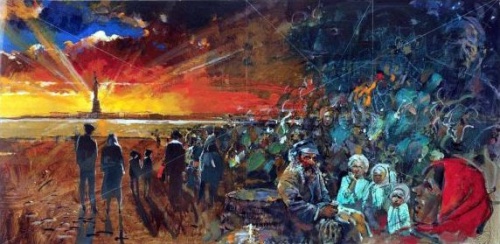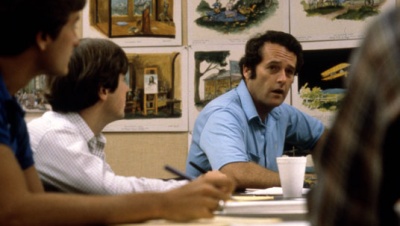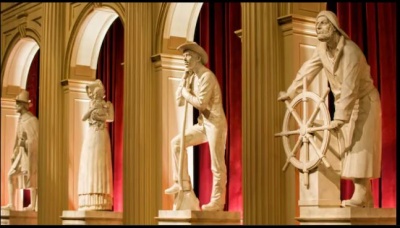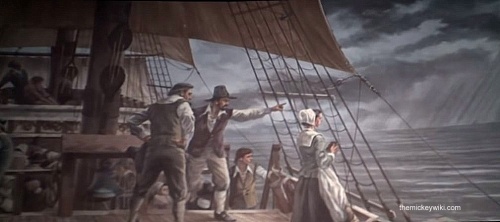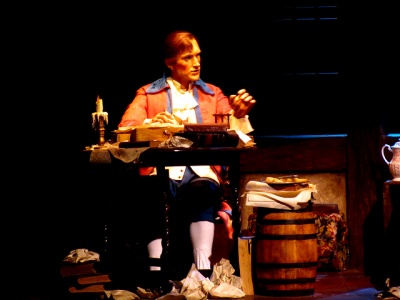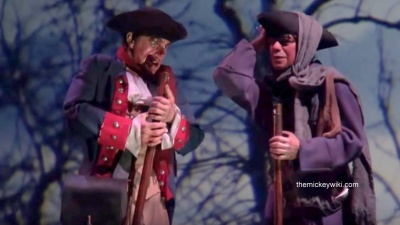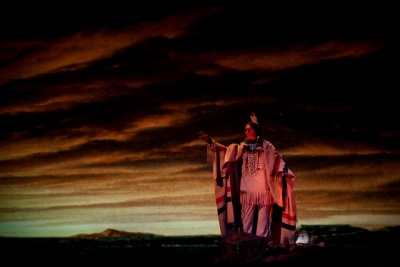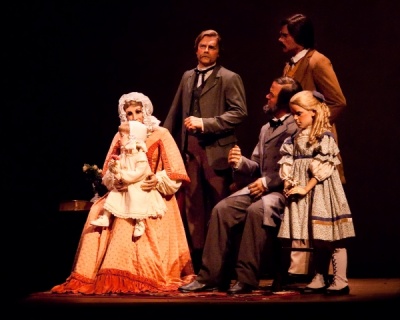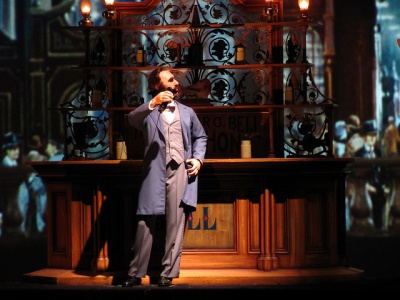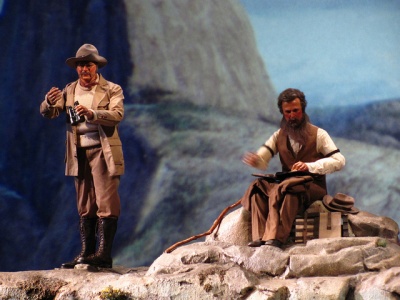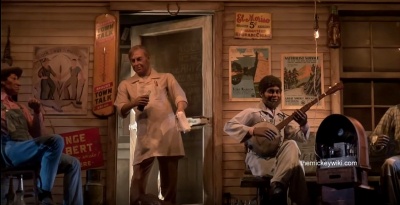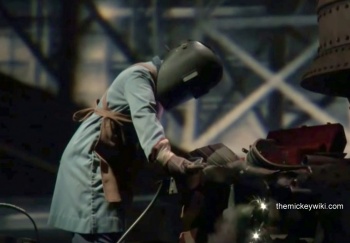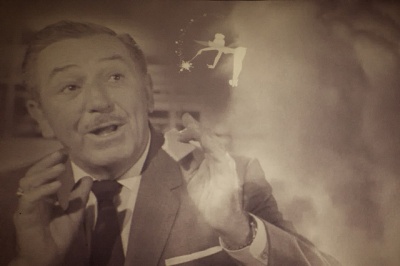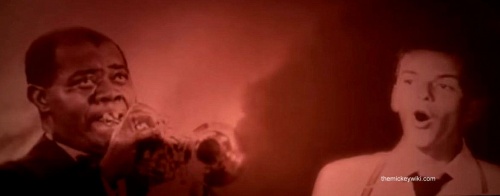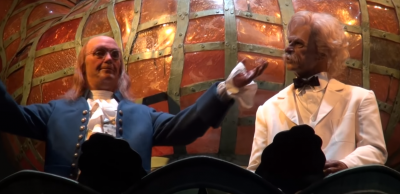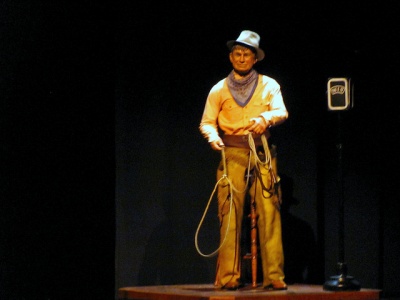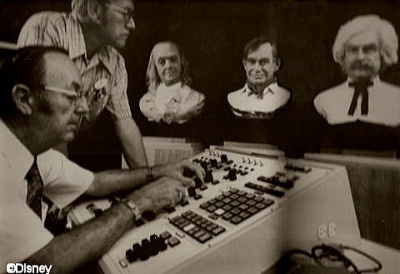The American Adventure (Attraction)
| The American Adventure (Attraction) | |
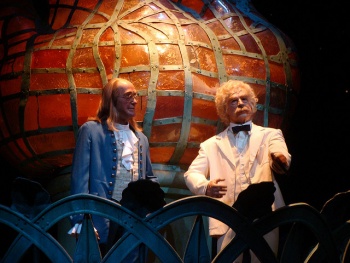
| |
| Mark Twain and Benjamin Franklin host The American Adventure | |
| Epcot | |
| Land | American Adventure |
|---|---|
| Attraction type | Show |
| Theme | American History |
| Opening date | October 1, 1982 |
| Hosted by | Benjamin Franklin and Mark Twain |
| Ride duration | 28:30 minutes |
| Audio-Animatronics | 35 |
| Theater Capacity | 1000 guests |
| Disney Genie + | No |
|
| |
The American Adventure is an attraction located within the American Adventure pavilion in Epcot. If you are looking for the pavilion that houses the attraction see: American Adventure (Pavilion)
Contents
- 1 Attraction History
- 2 Attraction Plot
- 2.1 Corridor of Flags and Preshow
- 2.2 Opening Scene
- 2.3 New World Bound
- 2.4 The Deceleration of Independence
- 2.5 In the Days of '76
- 2.6 Westward Expansion and Slavery
- 2.7 Two Brothers
- 2.8 Late 19th Century
- 2.9 Early 20th Century, WWI, and the Great Depression
- 2.10 World War II
- 2.11 Golden Dreams
- 2.12 Finale
- 3 Songs
- 4 Will Rogers Script
- 5 Fun Facts and Trivia
- 6 References
Attraction History
While an attraction inside the America pavilion had always been a part of the plans for EPCOT Center, its location and design changed frequently during the park's planning. As early as 1976, there were plans for an American attraction to be one of Epcot Center's major draws [1]. By 1978, Imagineers wanted to use the American Adventure pavilion as a bridge between Future World and World Showcase [2] [3]. This version of the pavilion would have been two stories tall, with the American Adventure attraction located on the building's second floor [4]. Eventually however, Imagineers decided to place the American pavilion within World Showcase. By placing the pavilion at the back center of the land, Imagineers not only put America amongst the other countries, but they also created a "weenie" to draw guests back into the land [4].
Like the pavilion itself, the American Adventure attraction also went through a series of changes. When development began on the attraction, Imagineers knew that they wanted to tell the story of America, but they were not sure how to do it. Six different attraction ideas were disregarded, before the show’s final form was accepted [5]. These discarded ideas included:
- An idea for a lighter attraction that would only feature Audio Animatronics. [6]
- A ride through attraction featuring short vignettes [6].
- An attraction which focused on the characters of American folklore (ie. Paul Bunyan) [6]
According to Show Writer and Producer Randy Bright:
“One of the toughest things we had to do was take 350 years and compress it down to 20 minutes. In fact, we failed. It is a 28-minute show. We went through six abject failures before we got to an American Adventure we all felt comfortable with, which ultimately became what we have today [7]
With a goal of creating a venue that would be “alive and moving” [1], Imagineers eventually came up with the idea of creating a “Magic Theater” [7]. The theater was designed so that it would be able to combine: Audio Animatronics, video, audio, and moving sets to tell the story of America [7].
With the infrastructure and form of the attraction now settled on, Randy Bright and his team set about writing the shows script. Early on, Bright proposed the idea of focusing on “dreamers and doers”, an ethos that would guide the show's development [8]. Bright and professor of history at UCLA D. Allen Yarnell would meet late at night at Imagineering to work on the show. One of the theme that they hoped to portray was the overcoming of adversity, while also not wanting to whitewashing the country's history [8]. Bright further noted that the show focused on a series of individuals using their own words.
In order to help set the various scenes which were to be depicted in the American Adventure, Imagineers initially wanted the attraction to have three hosts, with each host representing one of the centuries that America had existed for [6]. The three men chosen to guide guests through the story of America were Benjamin Franklin (18th century), Mark Twain (19th century), and Will Rogers (20th century). Although promoted in concept art by Disney [9], it was eventually decided that Will Rogers would not appear as one of the attraction's hosts (although he would appear in Audio Animatronic form in the 20th century scene), leaving the duo of Franklin and Twain as the sole narrators. This decision was made after Disney discovered that only 5 out of every 150 college students knew who Will Rogers was [7], and they could not come to a consensus on a replacement. Bright later contemplated that the events of the 20th Century were too current to properly find a representative for [7]
The soundtrack for the American Adventure attraction was carefully created by composer Buddy Baker, who combined known, period specific songs, with new tunes written specifically for the attraction[8]. The music was then recorded by the Philadelphia Symphonic Orchestra before being mixed by engineer Bob Zalk [8]. In total, it took 18 months to mix the attraction's music, sound effects, and narration into the final score [1].
Like the attraction's score, the artwork used in the American Adventure was specifically curated. Bright noted that they did not want to use "modern art" in the 18th and 19th century scenes [1]. Instead, Disney created new artwork that was stylized to look like it was from the correct period. In a similar fashion, photographs and motion pictures were not used until the scenes set in a time where these technologies had been invented [1].
Despite technical problems and changes to the show's plot, the American Adventure was completed in time for EPCOT Center’s opening day on October 1, 1982 [10]. The show then remained unchanged until 1993, when all new Audio Animatronics were added (which featured more fluid movements) and the attraction’s Golden Dream montage was updated [3]. In 2007, the montage was once again updated [3].
In January 2018, the American Adventure attraction closed for a major renovation. At this time, the attraction's films were converted to an all-digital projection system, and a new screen, as well as new speakers, were instilled[11]. Furthermore, at this time, the attraction's Golden Dream montage was re-recorded and updated to include new American icons. The attraction reopened on February 14, 2018 [12].
Attraction Plot
Corridor of Flags and Preshow
After entering the American Adventure pavilion (and listening to the Voices of Liberty Perform), guests leave the main rotunda and enter the Corridor of Flags. As visitors move the pavilion's second floor, 44 different flags from American history are showcased. Flags located here include Revolutionary War era flags, Colonial flags, and even foreign flags from the countries that first came to America [13]
Following the Corridor of Flags, guests enter the main theater. Here, 12 life size statues can be seen on the left and right walls. The statues represent the "Spirits of America" and they include:
- Spirit of Individualism- A cowboy
- Spirit of Innovation- A scientist
- Spirit of Tomorrow- A woman holding a baby
- Spirit of Independence- An American colonial solider
- Spirit of Compassion- A female doctor
- Spirit of Discovery- A mountain man
- Spirit of Freedom- A male pilgrim
- Spirit of Heritage- A Native American woman
- Spirit of Pioneering- A male aviator
- Spirit of Knowledge- A female teacher
- Spirit of Self-Reliance- A farmer holding a shovel
- Spirit of Adventure- A sailor
Opening Scene
The American Adventure begins in complete darkness, as guests hear the voice of Benjamin Franklin quoting John Steinbeck. As the first scene rises, guests see Franklin sitting behind a desk reading, with Mark Twain seated nearby. As Twain begins to doze off, Franklin concludes his Steinbeck quote by saying:
Stained and tinted with all colors, a seeming ethnic anarchy.
Then in a little time, we became more alike than we were different.
In society, not great, but fitted by our very thoughts for greatness.— Ben Franklin
The two men then begin to banter about humility, before Twain says that the American Adventure should begin with Franklin. Franklin corrects him, saying that the story of America began even before his time. As he speaks, images of ships crossing the ocean, and then a picture of the Mayflower reaching America, are shown.
New World Bound
At this point, the attraction's first song, “New World Bound” begins to play. As the song play, images of pilgrims coming to the new world are shown. The song tells the story of the troubles that the pilgrims faced, both coming to America and then subsequently surviving there. The lyrics to New World Bound are:
♫ There's a land cross this ocean,
I'm waiting to see.
A land for these people
who dream to be free.
So stand by the mainsail,
the fierce storms will race
aloft with our king mates
King Neptune we'll face.
You think that these landlubbers
never would last,
this cargo of pilgrims,
twelve weak for the mast.
It's "Land ho!" me hardies,
at last we've arrived.
and praise be to God,
nearly all have survived.
But look o'er this wilderness,
brings me to dread,
that the first bitter winter
ill leave 'em all dead.
They call themselves pilgrims,
these poor wretched souls.
With a dream to be free,
in the new world, there goal. ♫
The Deceleration of Independence
After New World Bound ends, Benjamin Franklin informs guests that America was not an easy place for settlers. He then goes on to explain that in future decades, America would face a new problem- a growing separation from Great Britain. Colonists are then shown on the screen, rallying against British rule and debating what to do. Franklin informs guests that:
First we spoke out with our voices, then we spoke out with action, with a growing defiance, that led to the Boston Tea Party.— Ben Franklin
At this point in the attraction, the screen goes dark and a large glass scroll comes down from the ceiling. The scroll is proclamation from King George III, telling the colonists that in response to the Boston Tea Party, Boston Harbor will be closed. As colonists debate the merit of revolution, Franklin explains to guests that finally it was time for action. As the glass scroll is raised back up, it reveals Thomas Jefferson sitting in his loft, working tirelessly. As the young Virginian continues his work, Benjamin Franklin climbs up the stairs to enter the room. After an exasperated Jefferson proclaims that John Adams should have been the one to write the Declaration of Independence, Franklin reassures him that he is the only man for the job. After making a joke about Franklin falling asleep during the last session of the Continental Congress, Jefferson explains that the Congress was able to ratify a final version of the Declaration. He then reads:
We hold these truths to be self-evident, that all men are created equal.That they are endowed by their creator with certain inalienable rights, that among these are life, liberty and the pursuit of happiness.
— Thomas Jefferson
In the Days of '76
Following the reading of the Declaration of Independence, scenes of the American Revolution are shown on the screen as guests hear the traditional song “In the Days of '76”. The song begins:
♫ In the days of '76, my boys, we never must revere That every man takes his musket up and fight for freedom dear. We'll hit the flanks Of the Redcoats' ranks as Yankee volunteers.
Oh, tis a great delight to march and fight, But it's getting tough, I fear... ♫
At the end of the first verse, a painting of Valley Forge is shown. At this point, two Revolutionary War soldiers and George Washington rise to the stage. The two soldiers commiserate about the difficult conditions at Valley Forge, and the luxuriously lifestyle the British troops are living in Philadelphia. The song then continues:
♫ In the days of Valley Forge, my lords, forever we must hail We fight the cold with bags on our feet, as the lobster backs regail
Oh, the time will come When they'll be on the run As their ships will homeward sail.
Oh it's a great delight to march and fight Along the victory trail... 'Tis a great delight to march and fight Along the victory trail! ♫
At the conclusion of "In the Days of ‘76", the images of the Revolutionary War stop. Guests are then shown an image of the 13 united colonies, as Benjamin Franklin comments:
In the end, we the people, prevailed and achieved perhaps our greatest dream.Thirteen very different colonies became the United States of America, and we were free to become an entire nation of dreamers and doers.
— Benjamin Franklin
Westward Expansion and Slavery
Following the end of the Revolutionary War, Mark Twain takes over as the show's primary host. Twain announces that subsequent to its establishment, America was Westward bound, and heading to new frontiers. As images of horses, Indians, frontier men, and a panhandler flicker across the screen, Mark Twain tells Franklin:
Yes sir, Dr. Franklin, you founding fathers gave us a pretty good start, don't ya know.
We still had some things to learn the hard way.
It seems a whole bunch of folks found out "We the people", didn't yet mean all the people.
Folks like Frederick Douglas.— Mark Twain
At this point Frederick Douglass is shown on a raft, floating down the Mississippi River. Douglass then speaks to Twain directly saying:
Even amidst the cricket song here along Mark Twain's beloved Mississippi, I hear the noise of chains and the crack of the whip. Yet there's hope.
Hope born from the words of Harriet Beacher Stowe.
Uncle Tom's Cabin has given our nation a key, which can unlock the slave prison to millions.
Anti-Slavery is no longer a thing to be prevented.
It has grown too abundant to be snuffed out, like a lantern.— Fredrick Douglas
As Douglass drifts away, the screen once again goes dark. A family getting their portrait taken in Matthew Brady's studio then rises to the stage. The two brothers are heard arguing over the merits of Southern succession from the Union. As their father tells them not to ruin their mother's birthday, their mother states that she is just happy that the whole family is all together. As a camera flashes (taking the families’ picture) the song “Two Brothers” begins to play.
Two Brothers
As images showing the Civil War are shown on the screen, Two Brothers continues in the background. The song tells the story of brothers who end up fighting on opposite sides in the Civil War. It is inferred that the song is talking about the family who was previously shown getting their portrait taken. The lyrics to Two Brothers are:
♫ Two brothers, on their way.
Two brothers on their way,
Two brothers on their way,
One wore blue and one wore grey.
One wore blue and one wore grey
As they marched along their way
The fife and drum began to play
all on a beautiful morning.
One was gentle, one was kind
One was gentle, one was kind
One came home, one stayed behind
A cannonball don't pay no mind.
A cannonball don't pay no mind
if you're gentle or if you're kind
It don't think of the folks behind
all on a beautiful morning,
all on a beautiful morning...
Two brothers on their way,
Two brothers on their way,
One wore blue and one wore grey.
One wore blue and one wore grey
As they marched along their way
The fife and drum began to play
all on a beautiful morning.
One was gentle, one was kind
One was gentle, one was kind
One came home, one stayed behind
A cannonball don't pay no mind.
A cannonball don't pay no mind
if you're gentle or if you're kind
It don't think of the folks behind
all on a beautiful morning,
all on a beautiful morning... ♫
At the end of the song the family portrait is shown again. This time however, one of the brothers fades away due to the fact that he died in the war.
Late 19th Century
Following the end of Two Brothers, Franklin tells guests that the Civil War had finally ended and with the country rebuilding, immigrants began to pour into the United States. As Franklin begins to comment that there "Seems there was a new dawn coming for the American Adventure", he is cut off by Chief Joseph. The Indian chief emerges from below the stage, and responds to Franklin's claim, saying:
Enough! Enough of your words!
Let your new dawn lead to the final sunset on my people's suffering.
When I think of our condition, my heart is heavy.
I see men of my own race treated as outlaws or shot down like animals.
I hope that all of us may be brothers with one country around us and one government for all.
From where the sun now stands, I will fight no more.
Forever...— Chief Joseph
As Chief Joseph disappears, the sunset behind him turns into a starry night. Mark Twain then returns to the stage, telling guests that "The wisdom of the Great Chief Joseph, reminded us once again of our long painful journey through the frontiers of human liberty".
As the scene changes, guests see the Great Hall in Philadelphia, which is hosting the Centennial International Exhibition of 1876. In front of the hall, four booths rise up housing: Mark Twain, Alexander Graham Bell, Andrew Carnegie, and Susan B. Anthony. As Susan B. Anthony gives a short speech advocating for women's suffrage, Mark Twain informs guests that they are back in Philadelphia again, and that America is a hundred years old today. Carnegie, Twain and Graham Bell then discuss the latest inventions of the day, with Carnegie summing up that it is the “age for grand ideas”. Graham Bell and Anthony chime in that it is also an era for innovation, and a dawn of new awareness.
As the booths descend, guests are shown dioramas which feature the latest technological advancements. Among the inventions featured are the light bulb, trolley, moving picture, and the airplane. Following these achievements, Mark Twain observes that the country was flying into the 20th century on the wings of invention and the winds of change. Because of the changes happening in the country, Twain also observes that America needed people like Teddy Roosevelt and John Muir to lead it.
Early 20th Century, WWI, and the Great Depression
At this cue, Teddy Roosevelt and Jon Muir are shown on stage standing in a forest. The two men are discussing the need for balance between industrial progress, and conservation of the environment. Muir is eventually able to impress upon the President that Roosevelt needs to stop the massive destruction of America's national parks. After Roosevelt says he agrees that they need to protect the country's resources, Muir says:
Then start it here and now.
Make this valley a part of Yosemite National Park.— John Muir.
Following the proposal, the rock that Roosevelt and Muir had been standing on lowers into the stage. Mark Twain then comments that that "Ready or not, we were soon thrust into the hectic role of a world leader and into the war to end all war". Following this proclamation, footage of World War I is shown, including a video of the Sopwith Camel, with the caption, "Another enemy airplane falls to America's gallant ace Captain Eddie Rickenbacker.” After this, the scene changes again, this time to a parade being held in honor of Charles Lindbergh. A news report is then heard, during which the newscaster tells guests that Lindbergh successfully made a solo flight across the Atlantic Ocean aboard his plane the “Spirit of St. Louis”. As the newscast finishes, guests hear a second newsman who tells them, that on October 29, 1929, the stock market has crashed.
Following the news, a scene depicting a gas station during the Great Depression appears on stage. Four men are sitting on the front porch, listening to a banjo player signing “Brother Can you Spare a Dime?”.
♫ Once I built a tower to the sun,
brick and rivet and vine.
Once I built a tower, now it's done.
Brother, can you spare a dime? ♫
As the song finishes, the men discuss the state of the country, joking about how millionaires in New York are selling apples just like they are. As the storm around them begins to let up, the gas station owner hopefully suggests that Sunday drivers might now venture out for gas. In the middle of their conversation, one of the men shushes the others, so that they can listen to Franklin Delano Roosevelt being inaugurated on the radio.
At this point in the scene, FDR appears to the left of the gas station, behind a presidential podium (with his unique seal on it). Roosevelt gives a short speech, concluding with "Let me assert my firm belief, that the only thing we have to fear is fear itself.” After hearing this, one of the men comments that America could use some prosperity, before they quietly listen to Will Rogers, who is now on the radio. As he continues to speak, Will Rogers can be seen on the right side of the stage, twirling his lasso and standing behind a studio microphone. Rogers says:
But ya know, it seems to me, that we was a mighty cocky nation.We had begun to believe that the height of civilization was an automobile, a radio, and a bathtub. Course now we're a lot smarter. Now Congress wants to trim down the Navy, so it will fit in the bathtub too. Ya know, it seems to me like we're the only nation in the country, that waits 'til they get into a war, before we start getting ready for it.
— Will Rogers
As Will Rogers finishes, another radio announcer speaks: "Yesterday, December 7th, 1941, a date which will live in infamy, the United States of America was suddenly and deliberately attacked by naval and ground forces..."
World War II
As the gas station fades away, a shipyard is shown. Here Rosie the Riveter is welding a piece of a battleship as "I'll be Home for Christmas" plays over the radio. After the conclusion of the song, the radio announcer says:
Yes, that was dedicated to you, Rosie, tens of thousands of you across the face of America working tonight to keep our boys in the fight.
We wish all of you out there, a very Merry Christmas.
Following the radio announcement, Rosie and a sailor discuss the state of the ship, before another worker emerges on a lift. She says, that it's no wonder they are all working double shifts on Christmas, before Rosie tells her to cheer up, and that maybe they will all be together next Christmas. As the battleship disappears, the screen turns purple and an eagle flies across it.
Golden Dreams
Following the World War II scene, the Golden Dream montage begins to play. During the song images and video of famous Americans from the 20th and 21st century are shown. The lyrics for Golden Dream are:
♫ Male Singer:
America, spread your golden wings
Sail on freedom's wind, across the sky.
Great bird, with your golden dreams
Female Singer:
Restless one in a world of change,
keeping dreams aloft in the rain.
Spirit free, soaring through the clouds
of time, of time.
Male Singer:
America, you must keep dreaming now
Dreaming the promised vow of your pioneers
America, keep on flying now.
Keep your spirit free.
Facing new frontiers. ♫
Some of the Americans shown during the Golden Dreams montage include:
|
|
|
After the montage ends, guests see the Apollo 11 rocket blasting off to the moon. Following the launch, Golden Dreams commences:
♫ Female Singer:
Spirit free, you must keep flying now,
Reaching to touch the sky
on the winds of change.
Oh restless one, search for brighter days,
Soaring through stormy skies
With our head held high.
Both:
America, spread your golden wings
Sail on freedom's wind across the sky.
Great bird with your golden dreams,
Flying high, flying high,
Flying high, flying high! ♫
Finale
Following the Golden Dreams montage, guests are taken to New York Harbor where Mark Twain and Benjamin Franklin have reconvened atop the Statue of Liberty. Here, the two Americans look back on the country’s history, and look forward at its future. While Franklin is optimistic about the future, Twain seems to be more cautious. To make his point, Twain quotes John Steinbeck (just as Franklin did at the beginning of the show) saying:
"We now face the danger, which in the past has been the most destructive to the humans: Success, plenty, comfort and ever-increasing leisure. No dynamic people has ever survived these dangers.
After a little more banter, Twain and Franklin eventually both agree that they see America lasting for a long time. As the show concludes, Golden Dreams plays one more time:
♫ America, you must keep dreaming now
Dreaming the promised vow of your pioneers.
America, keep on flying now.
Keep your spirit free,
Facing new frontiers.
America, spread your golden wings
Sail on freedom's wind across the sky.
Great bird, with your golden dreams,
Flying high, flying high, flying high!
America!
Keep on flying high! ♫
Songs
The American Adventure features five songs, they are:
New World Bound- Played during the scene depicting the pilgrims. “New World Bound” was written by X. Atencio and Randy Bright, with music by Buddy Baker [15].
In the Days of '76- This traditional song is played during the Revolutionary War scenes.
Two Brothers- Written by Irving Gordon and performed by Ali Olmo, “Two Brothers” is played during the Civil War scene [16].
Brother, Can You Spare a Dime?- Written by E.Y. Harburg, with music by Jay Gorney [17], “Brother, Can You Spare a Dime?” is played on the radio during Great Depression scene.
Golden Dream- Played during the attractions final montage, Golden Dram was written by Randy Bright and Lynn Hart, with music by Robert Moline [16]. The song was re-recorded for the 2018 update under the supervision of producer Harvey Mason Jr in Los Angeles[18]. Golden Dream is now performed by Tim Davis and Sophia Pizzulo [19].
Will Rogers Script
Although Will Rogers was eventually dropped as the host of the 20th Century, a script featuring Rogers as a host still exists. Below is the first scene in an early version of the American Adventure.
Ben Franklin: America has been settled by the people of all nations. We are not a narrow tribe of men, no. Our blood is as the flood of the Amazon, made up of 1,000 noble currents all pouring into one. We are not a nation so much as a world.” Excuse me, Mr. Twain, Mr. Rogers. I am sure you recognize those inspiring words from Herman Melville. It seems they are going to preamble a new show called the American Adventure. It also seems that we three have been asked to be the central figures in the show..
Mark Twain: The three of us star in a show together? I can see it now. Hmm! I just bet Mr. Rogers would love to step on my lines.
Will Rogers: Now, now, Mr. Twain, you know that’s not true.
Twain: Why, Mr. Rogers, you know truth is the most valuable thing I have.
Rogers: Well, I guess that’s why you use it so sparingly.
Franklin: Gentlemen, gentlemen, we are not addressing the issue at hand: The American Adventure.
Twain: Frankly, I’m sick and tired about all the grousing about what’s wrong with America. We should make it fashionable again to talk about all the things that are right about this country.
Franklin: I agree. The time has come to make an optimistic statement about America and her people.
Rogers: Well, sir, not just about the days gone by, but about today’s world and tomorrows, too. Don’t forget, we passed from the scene a long time ago.
Franklin: Mr. Rogers, I’m sure that if anyone can offer a new perspective on America’s challenges for tomorrow, we can. I may have invented these bifocals I’m wearing but I can assure you they’re not rose colored. Don’t forget, that between the three of us there is a lot of first-hand experience during the first two centuries. We were there.
Twain: Two-hundred years, that’s an awful lot of ground to cover.
Franklin: We can each take the period we’re the most familiar with. I should host the show right through the birth of a new nation.
Twain: I can cover the growing expansion of the American frontier.
Rogers: I sorta guess things have been kinda crazy in the 20th century. Changes faster than any of us could keep up.
Twain: Just look around us. Decaying cities, pollution, crime. I’d rather put my crystal ball in reverse.
Franklin: Now, stop that nonsense. Those good old days that everybody speaks of, they were no utopia either. Mr. Twain, those Mississippi shores you walked as a boy were also walked by slaves. And Mr. Rogers, how about the lawlessness and violence of your glorious West?…And in my time, few children lived to be adults. If I may quote you from my own Poor Richard’s Almanac: ‘The golden age never was the present age.’ Mr. Twain, if you want to go back, go right ahead, but from what I’ve seen, the 20th Century has an incredible amount of positive things that are simply taken for granted. [7]
Fun Facts and Trivia
- Randy Bright, the American Adventure's producer, helped write the song Golden Dream. [6]
- There are 35 Audio Animatronics in the American Adventure.
- There are 1,024 seats in the American Adventure theater.
- Some of the Audio Animatronics in the American Adventure have wigs made of human hair [20].
- Each wig costs $13,000 [20].
- The furniture in many of the scenes in the American Adventure are actually antiques[20].
- The American Adventure marks the first time that the Audio Animatronics voices come out of individual speakers, not the theaters main speaker system [20].
- Disney asked the Library of Congress for permission to recreate FDR's unique presidential seal [20].
- Imagineers researched old magazines to find appropriate ads to use in the Great Depression scene [20].
- Disney Imagineer Jeff Burke portrayed the brother who fights for the Union in the Two Brothers scene [21].
- Imagineer John Olson portrayed the brother who fights for the Confederacy in the Two Brothers scene [21]
- The farmer Spirit of Self-Reliance was based on Blaine Gibson's father. When WDI asked him to make the farmer less stoic, Gibson refused saying, "that's how I remember him" [22] [23]
- Walter Tyler designed the sets for The American Adventure [24].
- The shoes for the banjo player in the Great Depression scene were found in an old condemned relief mission in Los Angeles [8].
- The Ben Franklin animatronic has 52 different movements [1]
References
- ↑ 1.0 1.1 1.2 1.3 1.4 1.5 https://www.youtube.com/watch?v=pT8dbXhN1G8
- ↑ http://progresscityusa.com/2009/06/27/a-visit-to-epcot-center-1979/
- ↑ 3.0 3.1 3.2 http://www.martinsvids.net/?p=218
- ↑ 4.0 4.1 http://allears.net/tp/ep/e_adv.htm
- ↑ http://2719hyperion.blogspot.com/2007/01/lost-imagineering-happy-fun-american.html
- ↑ 6.0 6.1 6.2 6.3 6.4 http://allears.net/ae/issue828.htm
- ↑ 7.0 7.1 7.2 7.3 7.4 7.5 https://www.mouseplanet.com/9905/Will_Rogers_and_the_American_Adventure
- ↑ 8.0 8.1 8.2 8.3 8.4 https://www.youtube.com/watch?v=u8WTTQzuDZge
- ↑ http://progresscityusa.com/page/57/
- ↑ http://thisdayindisneyhistory.homestead.com/epcotgrandopening.html
- ↑ https://disneyparks.disney.go.com/blog/2018/02/epcots-american-adventure-attraction-will-add-new-american-icons-this-month/
- ↑ https://www.wdwmagic.com/attractions/the-american-adventure/news/14feb2018-video---the-new-american-adventure-golden-dream-finale.htm
- ↑ http://land.allears.net/blogs/jackspence/2010/12/the_american_adventure_part_1_1.html
- ↑ https://www.disneydocs.net/_files/ugd/5db718_0b875a96406e4bc4a103b184e3d1dc11.pdf
- ↑ http://themacgyverproject.blogspot.com/2015/10/47-new-world-bound.html
- ↑ 16.0 16.1 http://land.allears.net/blogs/jackspence/2010/12/the_american_adventure_part_2.html
- ↑ http://www.npr.org/2008/11/15/96654742/a-depression-era-anthem-for-our-times
- ↑ https://www.youtube.com/watch?time_continue=153&v=8SJde5SkS_U
- ↑ https://wdwnt.com/2018/08/new-2018-update-version-of-golden-dream-from-the-american-adventure-at-epcot-now-available-on-itunes/
- ↑ 20.0 20.1 20.2 20.3 20.4 20.5 http://allears.net/ae/issue435.htm
- ↑ 21.0 21.1 http://www.ravenswood-manor.com/jeffburke.html
- ↑ http://www.fromscreentotheme.com/FunFindFridayAmericanAdventure3.aspx
- ↑ https://twitter.com/BrianPMiles/status/625826938423222272
- ↑ Sklar, Marty. Dream It! Do It!: My Half-century Creating Disney's Magic Kingdoms. Disney Editions, 2013. Print.
